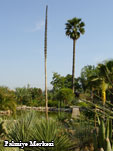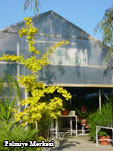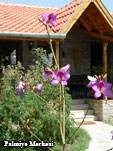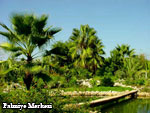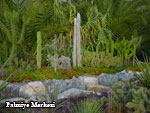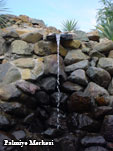 |
| |
|
PALMIYE MERKEZI (PALM CENTER) TURKIYE |
|
Palmiye Merkezi, was established by Dr. Ragip Esener in Koycegiz municiality of Mugla for spreading appreciation of Palms and to increase their variety in cultivation, in Turkiye. The Centre has an area of 80.000 m (861.113 ft). Part of this area gets flooded during winters and therefore is currently not being used. In the future it is planned to build water gardens in this area. Palm Centre during its beginnings has reserved an area of 5.500 m (59.200 ft³) for a first-in-Turkey “Palmetum”; a museum for living palms. Organisation of this area was started in 1996 and the first plantations were made in 1997. The Palmetum is surrounded by, Washingtonia palms “Washingtonia robusta” in the north, Datca Date Palms “Phoenix theophrastii” in the west, Queen Palms “Syagrus romanzoffianum” and trees of African origin in the south and by Oriental Arbor vitae “Thuya orientalis” in the east. Here, a 300 m (3230 ft) decorative pond contains Japanese “Koi” fish, and a Senegal Date Palm in the small island mid pond. Currently there are more than 40 species of palms in the Palmetum. In addition to palms, various species of perennial, annual, shrubs and tree type plants are situated here. |
|
|
In the course of time, number of species of non-palm type plants planted, have considerably exceeded that of Palms and further with the addition of a Cactus Greenhouse, a Tropical Greenhouse, Water and Grass Gardens, a small “Botanical Garden” has been borne. Our Botanical Garden which has been opened to visitors on the 1st of June 2006 is being visited particularly by foreign guests. Domestic visitors are mainly university students and their academic tutors on technical excursions and professionals in horticulture and landscape designers. The Centre is providing practical training (internship) opportunities to undergraduate and postgraduate students. |
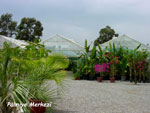 |
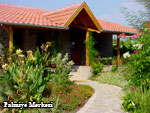 |
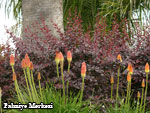 |
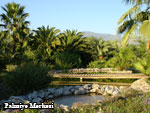 |
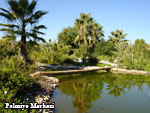 |
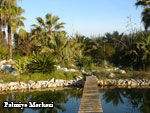 |
|
The Centre, has been continuing with studies on the cultivation, adaptation and growing characters of the Datca Date Palm; “Phoenix theophrastii”, one of the two Palm species endemic to the European continent. Additionally the Centre has supported the introduction of the “Golkoy Palm” a sub-species of “Phoenix theophrastii’, to the world botanical community. Apart from Palms, we have been experimenting on the cultivation and adaptation of various Cycads, and various other plants and trees originating from South Africa, Australia and Americas in our relatively cooler Mediterrenean Climate. The Centre has in the recent years gained experience on the endurance and adaptability of these varieties to colder climates. On this topic we have been helpful to the International Palm and Botanical Communities and researchers, through internet. 4000 m (43.056 ft²) of the land, has been allocated to Water and Bog gardens. Their developement were started in 1992 with the small lake. After 3 years of work, the small lake, now “Tourtoise Lake” and its island were completed. This has also facilitated the ground water level-swamp area management. In 2004 with the construction of 19 circular ponds, “Dream Garden” was created, where 17 varieties of water lilies and other water and swamp plants are exhibited. In 2005, during the second development phase of the Botanical Garden, a rectanguler pond where water plants are exhibited, was added. In 2005 the “Cactus and Succulent House” project, the construction of which started in the spring of 2004, was completed. In the spring of 2005, exhibition of some 300 varieties of cacti and succulents started inside and outside the Cactus House. Also in the same year an “Exotic Fruits Collection” in a small area behind the Cactus House, containing tropical, subtropical and interesting fruit bearing plants has been created. The “Oleander Cafe”, a rest area for the visitors, was designed and completed in June of 2005. The Centre has a collection of 30 varieties of Oleanders. The most important member of the collection is the “Nerium Oleander Esener” which has single pink flowers and variegated leaves in the shape of sickles. In 2006 the construction of the Tropical Greenhouse and the plantings were completed. Due to its limited resources, the Palmiye Merkezi (Palm Centre) has as yet no Research Laboratory. Nevertheless, studies are being conducted in greenhouse nursery environment, in the areas of germination, nutrition, development of new varieties, and seed life (viability) for the our native palms. Twin and triplet Jelly Palms; “Butia capitata” and “Butia yatay” which have been cultivated in our Centre have yielded their first fruits in 2003. Hybrid palms which we have developed in 2003 by cross breeding the Dwarf Palm “Phoenix roebellenii” and Senegal Date Palm“Phoenix reclinata” are continuing to grow. Almost all of the palms cultivated in the Palm Centre, have been grown from imported seeds. Today, however, through our Seed Bank sales, we provide seeds for many palms and plants which are commonly not available in Turkey. In 2005 we started export of seeds to other countries. From 2005 we also started sales of seedlings of new variety of palms to growers in addition to seeds, to broaden the varieties in cultivation in our country. |
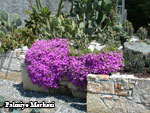 |
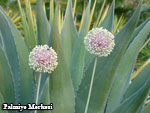 |
|
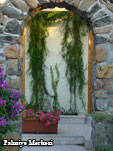 |


